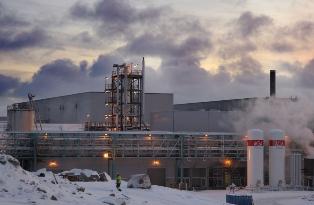Finnish company Talvivaara Mining is investigating modifying the metals extraction process at its Talvivaara nickel and zinc mine in Sotkamo, eastern Finland, in order to recover uranium as a by-product.
 |
| The processing plant at the Talvivaara mine could be modified to produce uranium (Image: Talvivaara) |
Talvivaara said that in its bioheapleaching process, small concentrations of uranium leach into the process solution (some 25 milligrams per litre) along with the company's main products: nickel, copper, zinc and cobalt. Currently, extremely small concentrations of uranium are deposited in an engineered gypsum pond intended for process precipitations, the company said. Talvivaara is now investigating the potential to modify its production process so that the uranium contained in the solution can be utilized as uranium oxide (yellowcake).
The company is considering recovering the uranium from its main leaching process by using a "safe and technically simple solvent extraction process which is widely applied to metals recovery." This process modification, Talvivaara said, "will not alter discharge levels or other environmental impacts of the operations, as defined in Talvivaara's current environmental permit."
Talvivaara said that it has drawn up tentative process plans in cooperation with process solutions, technologies and services company Outotec Oyj and Norilsk Nickel Harjavalta Oy, operator of the only nickel refining plant in Finland. The company will continue the development and engineering of the extraction process and the preparation of the necessary documentation for permit applications. It said, "The relevant authorities will determine terms and conditions for safe operation and the process will be properly monitored by them."
Some €30 million ($41.2 million) would need to be spent on modifying its extraction process, Talvivaara said, with annual production costs of around €2 million ($2.7 million). Annual uranium output would be about 350 tonnes which, according to Talvivaara, "would make Finland almost self-sufficient with respect to uranium."
Finland currently has four operating nuclear power reactors - two at Olkiluoto and two at Loviisa - with a combined generating capacity of 2696 MWe. A further 1600 MWe unit is under construction at Olkiluoto and is scheduled to start up in 2012. In 2010, Finland will require some 1149 tonnes of uranium to fuel its reactors. The country currently does not produce any uranium and imports all of its nuclear fuel.
The yellowcake produced would be packaged and transported for further processing. The product purchaser, Talvivaara said, will handle the further processing into nuclear fuel abroad, as Finland does not currently have any uranium conversion or enrichment facilities.
Talvivaara is currently in discussions with leading companies in the industry regarding a potential cooperation for this project, after which its final financing and operating model will be determined.
"The current project looks at exploiting valuable metals present in our ore body as by-products, as provided for by the Finnish mining legislation," said Talvivaara CEO Pekka Perä. "The development of our solvent extraction method demonstrates the innovative skills of our internal team and of our partner organisations and is a perfect fit with our strategy of carefully recovering precious and useful substances from our ore."
The Talvivaara deposit is one of the largest known nickel sulphide deposits in Europe. The mining licences in the area were originally granted to Outokumpu in 1986 and exploration rights to them were subsequently transferred to Talvivaara in February 2004. The Talvivaara deposit comprises two different polymetallic ore bodies, Kuusilampi and Kolmisoppi. The mineral resources in these ore bodies have been classified according to the JORC code. The combined measured and indicated mineral resource is 642 million tonnes at 0.23% of nickel, 0.13% of copper, 0.02% of cobalt and 0.51% of zinc.
The Talvivaara deposit, the company notes, contains uranium at an average grade of 15-20 part per million (0.0015-0.0020%), so "does not contain sufficient grades of uranium to be classified as uranium ore, nor could it support uranium mining."
Researched and written
by World Nuclear News





_18570.jpg)
_16159.jpg)
_49205.jpg)





